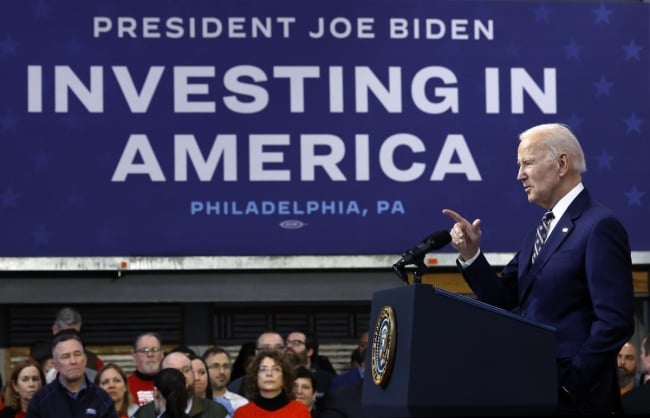You have /5 articles left.
Sign up for a free account or log in.

President Biden unveiled his fiscal year 2024 budget request Thursday. The proposal boosts funding for the Pell Grant and a number of other higher education–related programs.
Chip Somodevilla/Getty Images
President Biden is seeking a third increase to the annual Pell Grant, of $820, as part of his budget request to Congress, which was unveiled Thursday.
Department officials said the budget proposal, which is for fiscal year 2024 beginning Oct. 1, would help build a higher education system that grows the middle class, drives the economy forward and prepares students for highly skilled jobs.
The budget proposal is the opening salvo in what will likely be a fierce budget battle with House Republicans, who have said they want to return spending to pre-pandemic levels. House Republican leaders, including Speaker Kevin McCarthy, criticized the proposal as “reckless” and “unserious.”
Increasing the Pell Grant by is a key part of the administration’s plan to make college more affordable. The grant has increased by $900 in the last three years. The proposed increase would bring the maximum total award to $8,215. Officials say they are committing to doubling the maximum award by 2029.
The administration also is renewing calls for free community college with a $90 billion proposal over 10 years. Further, the administration wants $500 million to jump-start the free community college effort. The $500 million in discretionary funding would go toward partnering with states to pay for community college programs that lead to good-paying jobs in growing industries or four-year degrees. The American Association of Community Colleges did not have a comment Thursday.
The administration also is proposing a tuition subsidy of up to $4,500 per year for two years for students from families earning less than $125,000 who are enrolled in participating four-year historically Black colleges and universities, tribal colleges and universities, or minority-serving institutions. The vast majority of students at those institutions are from families below the cap.
The budget further proposes several investments in workforce training, including $335 million for apprenticeships in certain industries such as construction and clean energy, $100 million to help community colleges partner with employers to develop training models, and $200 million to connect high school students to community colleges and potential employees through dual enrollment, work-based learning and career advising.
The spending plan would give the National Science Foundation $11.3 billion—a nearly $2 billion increase from the current fiscal year—and $48.6 billion to the National Institutes of Health, an increase of $920 million.
The administration said the budget would decrease the country’s deficit by nearly $3 trillion over the next decade in part by proposing a new set of tax increases.
“We can provide students with opportunities and reduce the deficit,” Education Secretary Miguel Cardona said during a media briefing.
The budget requests an additional $620 million for federal student aid, which officials said was critical to ensuring that the agency can deliver on several projects, including simplifying the Free Application for Federal Student Aid and modernizing the student loan servicing system. The Office of Federal Student Aid did not receive additional funding in the current budget in part because of Republicans’ objections to Biden’s student loan forgiveness plan.
The budget request assumes that the administration moves forward with the debt-relief plan, Education under secretary James Kvaal said during a briefing for reporters.
Justin Draeger, president of the National Association of Student Financial Aid Administrators, applauded the Pell Grant increase in a statement as well as the additional funding for federal student aid.
“At a time when the Office of Federal Student Aid is already stretched thin and is implementing many critical initiatives, it cannot be understated how important it will be to ensure that the agency has the necessary resources to complete these monumental undertakings,” Draeger said. “At the same time, we realize that this proposal is just the beginning of a lengthy appropriations process. We call on our colleagues in Congress to work across the aisle to prioritize student aid funding and reforms that will ultimately benefit students and families.”
The budget also would send an additional $429 million to underresourced institutions such as historically Black colleges and universities, tribal colleges and universities, minority-serving institutions, and community colleges.
The administration is proposing $165 million more for student success grant programs and $150 million for mental health programs on college campuses, among other increases. Over all, the Education Department would see $10.8 billion more in discretionary funds under the budget proposal—a nearly 14 percent increase from the current federal budget.
Mark Becker, president of the Association of Public and Land-grant Universities, praised the investments in higher education and research.
“These proposed investments would increase access to quality and affordable higher education and bolster funding for pathbreaking research that saves lives, drives innovation, and improves living standards,” he said in a statement. “Robust investment in a skilled workforce and scientific innovation is vital to U.S. global competitiveness.”
Jon Fansmith, senior vice president for government relations at the American Council on Education, said in a statement that the association was pleased by the many financial aid, research and institutional support programs.
“While there are some areas of the budget request that we are concerned do not address the funding needs of the programs, we will continue to work with the administration and Congress to remedy that through the appropriations process,” he said.
The Institute for College Access & Success issued a statement praising the budget plan.
“Today’s proposal signals the administration’s commitment to our nation’s students and advancing racial and economic equity through higher education,” said the statement. “We now urge policymakers to make these and other essential investments to bring a high-quality, debt-free college education within all students’ reach; protect students and taxpayers from predatory colleges; and provide long-overdue relief to student loan borrowers.”




